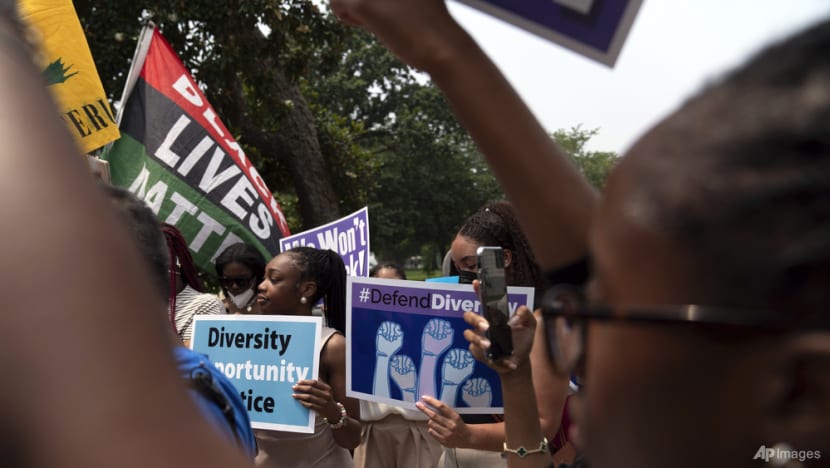Commentary: The real test for DEI is here. Many companies are failing
The DEI rollback in the US is a stress test, revealing which firms are genuinely committed to diversity and which were doing so for optics, says Stewardship Asia Centre’s Sunil Puri.


This audio is generated by an AI tool.
SINGAPORE: In his inaugural address in January, United States President Donald Trump declared: "We will forge a society that is colour blind and merit-based." Shortly after, his administration rolled back nearly 80 executive orders from the Biden era, many of which supported diversity, equity and inclusion (DEI).
Major corporations like Pepsi, General Motors, Google, Disney, Intel and PayPal have responded by scaling back or removing DEI references in their 2024 annual reports to investors.
According to a Financial Times report this month, 90 per cent of the top 400 companies in the S&P 500 index that have submitted annual reports since Mr Trump’s election have reduced references to DEI, with many ditching the term entirely.
If organisations genuinely viewed DEI as critical to business success, would they so readily abandon it in response to external pressures? Or does this suggest that many DEI initiatives were primarily about risk management and branding rather than fundamental business change?
Perhaps the real test of DEI is not when it is fashionable but when it is challenged.
As newly minted DBS Group CEO Tan Su Shan noted at a thought leadership event on Mar 12, leadership is about being responsible and companies should stick to their DEI commitments regardless of political developments.
“Don’t chop and change because you’re trying to ingratiate yourself with another administration,” she said. Ms Tan, who took over the top job on Mar 28 when Mr Piyush Gupta retired, is the bank’s first female CEO.
FROM DIVERSITY TO INCLUSIVENESS
A significant consequence of political and social shifts in the US is the decentralisation of DEI efforts within global organisations. As US-based firms face increasing pressure to scale back their DEI initiatives, regional offices are taking a more localised approach.
In many cases, these international branches are expanding their DEI strategies to align with local cultural values, regulatory requirements and workforce expectations.
For instance, while racial diversity has been a dominant DEI focus in the US, many Asian companies prioritise factors such as socioeconomic mobility, linguistic inclusion and interfaith accommodation. This localisation could suggest that one of the weaknesses of past DEI initiatives was their tendency to apply Western-centric frameworks globally without adapting to local realities.
Consequently, while DEI efforts may be contracting in the US, they are evolving in Asia and other parts of the world, with a key shift being from diversity to inclusiveness.
Diversity highlights and celebrates differences - such as race, gender and culture - while inclusiveness goes a step further, fostering a sense of belonging for all. Inclusiveness ensures that everyone, regardless of their background, feels valued and integral to the community. Many companies in Asia already take such an approach.
For instance, Singapore is a highly diverse society with a mix of Chinese, Malay, Indian and Eurasian ethnic groups, along with a variety of religious communities - Buddhists, Christians, Muslims and Hindus, to name a few.
Companies here often emphasise multicultural inclusivity, language policies and religious accommodations. Most local and even US firms operating in Singapore ensure that prayer rooms are available for Muslim employees and that company policies respect the diverse cultural festivals of different ethnic groups.
This suggests that companies that take a more holistic, culturally attuned approach to DEI may be better positioned to sustain their commitments regardless of political pressure, because their efforts are seen as necessary to business rather than reactive branding exercises.
Even if the DEI focus is on gender, Asian countries take a different approach to US firms. Japan, for example, has one of the lowest female workforce participation rates among developed countries. Still, instead of adopting Western-style gender quotas, companies there focus on work-life balance and parental leave policies to encourage women to stay in the workforce.
Meanwhile, LGBTQ rights may be central DEI priorities in Europe and the US, but Asia’s more conservative approach necessitates that DEI strategies be adapted to align with local cultural and societal norms.
MERIT-BASED SYSTEMS OR JUST A COURSE CORRECTION?
The reversals in the US present an opportunity to move beyond so-called “bad DEI” - defined by ideological conformity and a “cancel” culture that focuses on enforcing a narrow set of beliefs, stifling open dialogue and prioritising groupthink over constructive disagreement and authentic engagement.
This reframes the DEI conversation, making it less about political correctness and more about fair, merit-based systems that deliver real-world outcomes.
Perhaps this backlash is the necessary stress test DEI needed.
It has exposed the distinction between organisations that genuinely believe in DEI (the ones that have announced they will continue to pursue DEI despite the anti-woke narrative), and those that were doing it for optics. This is good for all stakeholders.
For example, Apple shareholders last month rejected a proposal to end its DEI initiatives, although CEO Tim Cook has signalled potential adjustments amid legal pressure. Â
Meanwhile, cosmetics company Lush created three new bath bombs named Diversity, Equity and Inclusion. “We believe that diversity, equity and inclusion are essential in building justice and belonging in the workplace - and beyond,” the company said.
If DEI is to survive, it must prove its value. Not in mission statements, but in measurable outcomes. That means moving beyond vague slogans and check-the-box exercises to demonstrate how diversity, when done right, fosters innovation, strengthens teams and improves long-term performance.
Sunil Puri is Senior Vice President, Research & Engagement at Stewardship Asia Centre. He leads the Research and Engagement team and is responsible for research and thought leadership, and he designs educational programmes, events, toolkits and frameworks.













